Known as the home of Brownsville and SpaceX, Cameron County is an important area for Texas and the United States as a whole. As one of the major population centers in south Texas, Cameron County acts as a hub for international trade and is a key part of the Mexican American border. While traditionally an area for working families and first-generation Americans, the county has grown as a business powerhouse in the last few years and is seeing a diversified economy being constructed. This decade of change has certainly brought many improvements to the area, but one of the few downsides is increasing property values and taxes, which is typically the price for a growing community.
Along with exemptions, one of the best ways to reduce taxable value is with property tax appeals. These have traditionally been underutilized in Cameron County, with under 6% of properties being protested as of 2023. As prices rise and as taxpayers become educated on how these appeals can help, the number of engaged residents should grow quickly. Currently, all informal appeals and formal hearings with the appraisal review board (ARB) are complete. This allows us to see how effective protests were in 2025, along with how we at O’Connor were able to help our clients in the journey to lower their taxes. This article will explore how things went for Cameron County across a multitude of factors.
Residential Appeals Lower Valeus by a Third
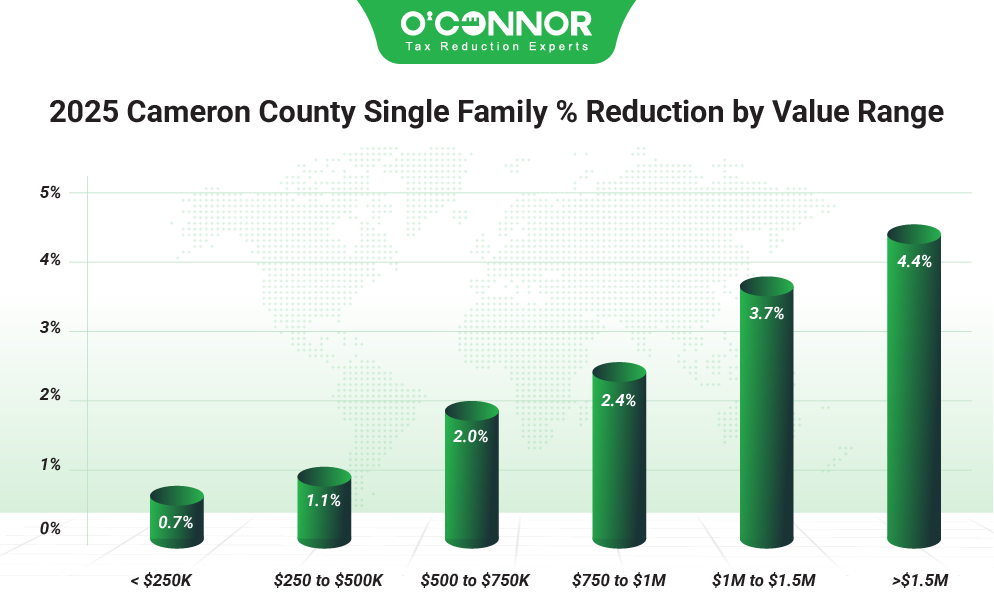
While not a dramatic spike like many other counties experienced, Cameron County homes still saw an overall increase of 3.1%, which took the grand total of taxable residential value to $23.78 billion. The Cameron Appraisal District (Cameron CAD) estimated that 27% of homes were overvalued. A combined force of appeals was able to achieve a reduction of 1.1% for the overall total, bringing it down to $23.52 billion. Homes worth under $250,000 were the largest block of value by far and reached $12.35 billion after a cut of 0.7%. Those assessed at $250,000 to $500,000 were reduced 1.1%, leaving a total of $8.10 billion. Residences assessed between $500,000 and $750,000 got a reduction of 2%, for a sum of $1.50 billion. O’Connor managed to save our clients 5.6% on home values overall, including a cut of 5.7% for homes worth under $250,000.
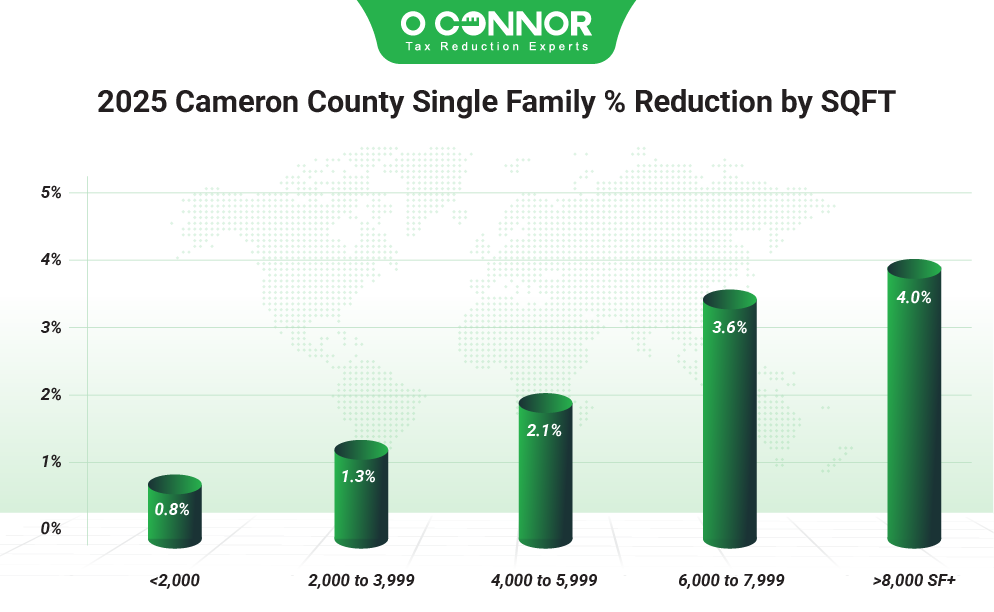
Most of the value in Cameron County when it comes to homes originates from those under 2,000 square feet. These modest residences were responsible for $14.17 billion after a reduction of 0.8%. Homes measured at 2,000 to 3,999 square feet got a better decrease of 1.3%, which meant a final sum of $7.60 billion. 4,000 to 5,999 square foot homes were reduced by 2.1%, totaling $989.73 million. The value of homes over 8,000 square feet was $543.10 million after a cut of 4%. This was twice the value of residences between 6,000 and 7,999 square feet, indicating an increase in mansions in the county.
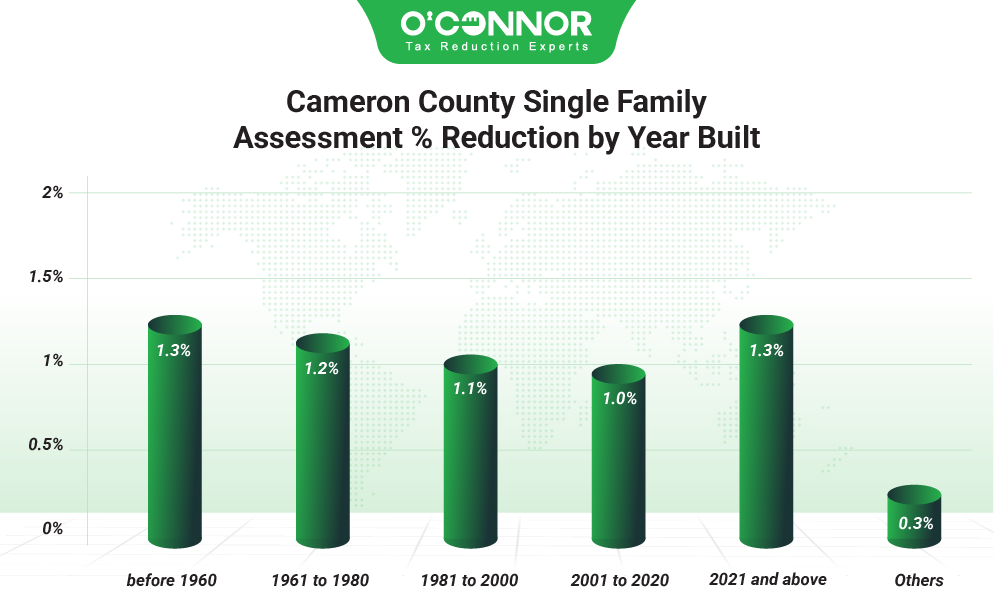
In what will become a common theme for all properties in Cameron County, most residential value was built in a boom period between 2001 and 2020, resulting in a value of $8.28 billion after a reduction of 1%. This has been universally seen across Texas. 27% of home value came from those built between 1981 and 2000, which resulted in a total of $6.36 after a cut of 1.1%. Older homes managed to hold on to their value, contributing $3.62 billion after a cut of 1.2%. New construction had added 28.9% to its total in 2025, but this was lowered 1.3% by appeals, translating into a final sum of $2.24 billion.
O’Connor Saves Commercial Owners 8.2% on Taxable Value
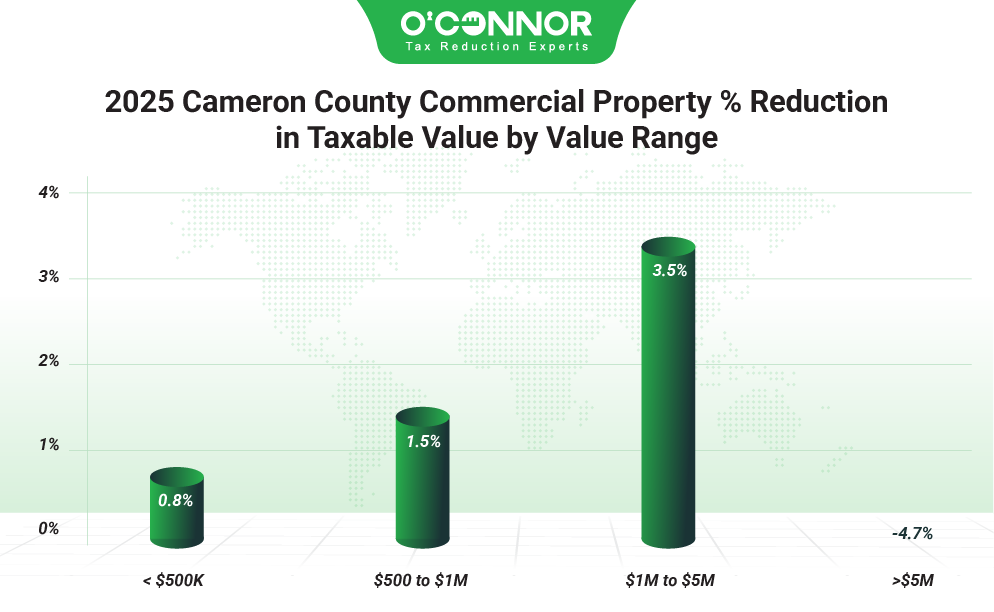
Cameron County saw an overall increase in commercial property value of 4.6%, which brought the total to $7.10 billion. While a somewhat sedate increase compared to similar counties, it still represented a large increase for many businesses. Tax protests were deployed, but not too much effect. Only 0.1% of commercial value was reduced, which meant the total was only cut down to $7.09 billion. The largest source of value, business real estate worth over $5 million, was adjusted by 4.7% during the appeal period, which translated into a final value of $1.98 billion. This was mostly from raw land. Commercial properties worth between $1 million and $5 million experienced a cut of 3.5%, which nearly halved the increase of 7.9%, producing a new total of $1.79 billion. Clients that chose O’Connor did much better, seeing an overall reduction of 8.2%, which translated into a savings of $26.44 million in taxable value.
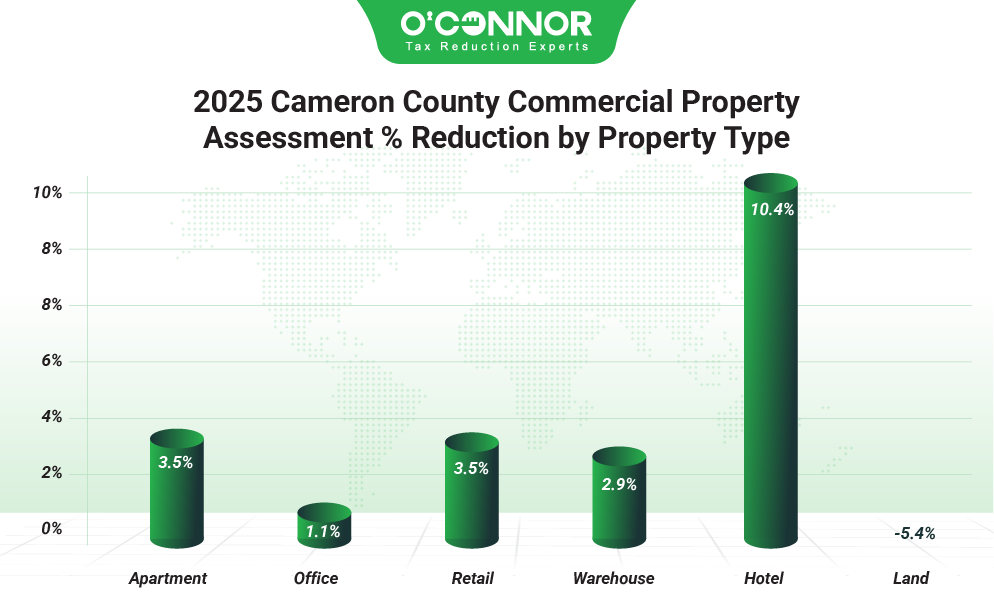
Much of the total reduction was skewed by a large spike in raw land value. The largest commercial value source, land, increased 5.4%, reaching a total of $3.02 billion. When broken down by category, we can see that properties outside of land did much better. Retail, the second-largest category, got a reduction of 3.5%, which wiped out the increase of 1.4%. This resulted in a final sum of $1.39 billion. Apartments had added 10% in 2025, but this was knocked down 3.5% to $1 billion. Offices dropped 1.1% to $768.05 million, which made a significant dent in the increase of 3.3%. Hotels saw a large decrease of 10.6%, which obliterated the uptick of 0.9%. Warehouses also managed a solid reduction of 2.9%, dropping to $444.24 million.
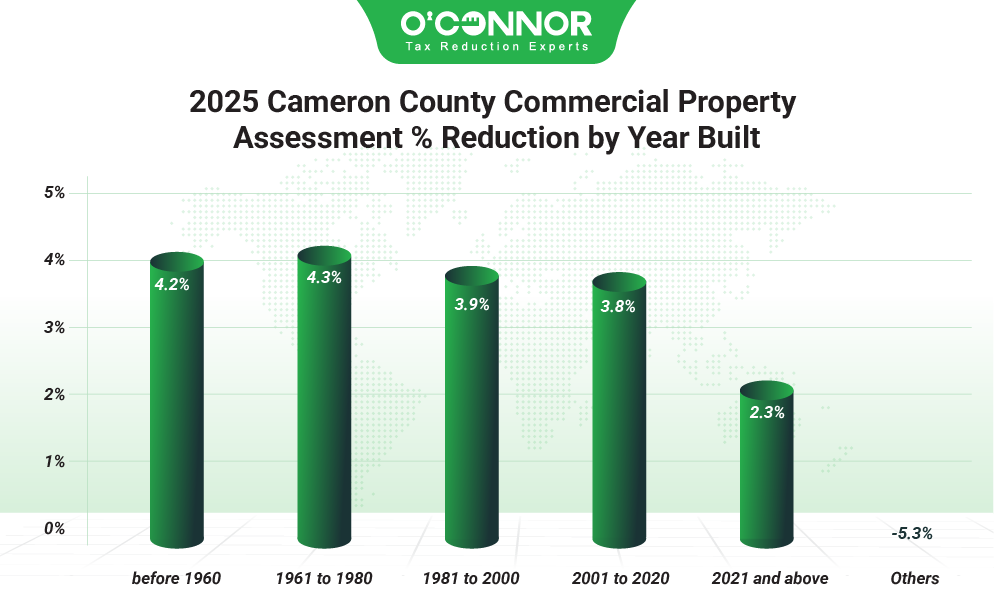
Raw land accounted for 42.7% of all value, showcasing how much Cameron County could grow in the next few years. Outside of that, commercial property followed the pattern set up by homes. The boom period of 2001 to 2020 was the main reservoir of value, being responsible for $1.77 billion of the total, following a reduction of 3.8%. $1.32 billion came from properties built between 1981 and 2000, following a good decrease of 3.9%. New construction was only responsible for 2.8% of the total, and received a reduction of 2.3%, resulting in a sum of $201.54 million. In general, outside of the land outlier, most construction timeframes saw significant cuts, many totally reversing previous increases.
Apartments Achieve a Reduction of 3.5% with Combined Appeals
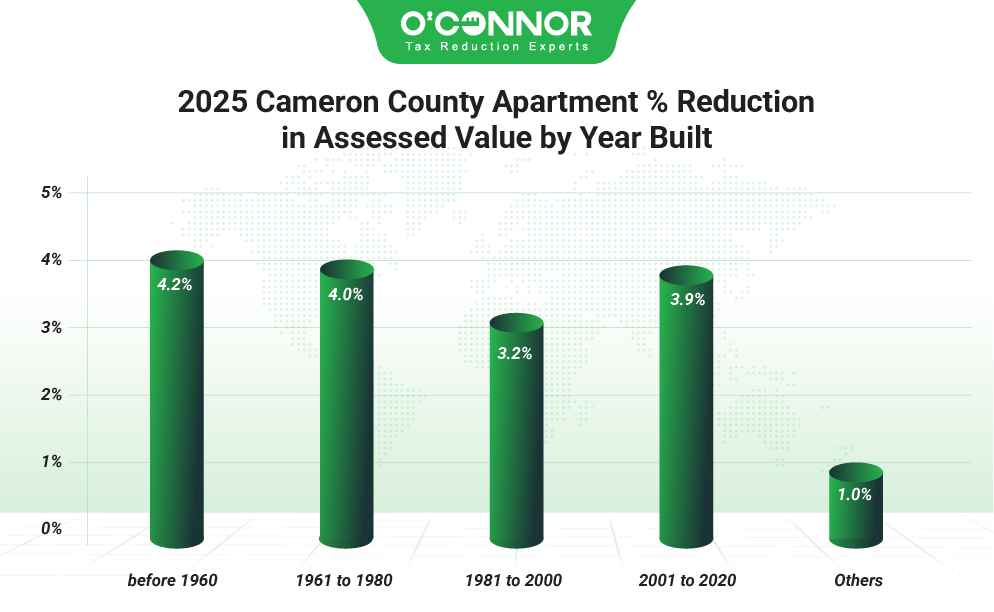
Apartments are typically the No. 1 source of commercial property in Texas, so them being in third place in Cameron County is quite unique. These multi family residences initially added 10.7% to their total in 2025, but this was countered by a cut of 3.5%. Like other properties, most of the value came from apartments built between 2001 and 2020, totaling $477.04 million after a decrease of 3.9%. $222.55 million came from those built from 1981 to 2000, while $187.84 million came from those built between 1961 and 1980. These saw reductions of 3.2% and 4% respectively. New construction had added 22.7%, but this was trimmed by 1%, resulting in a final figure of $83.88 million. O’Connor customers netted a total reduction of 5.4%, including a vital cut of 7.1% for apartments constructed between 2001 and 2020.
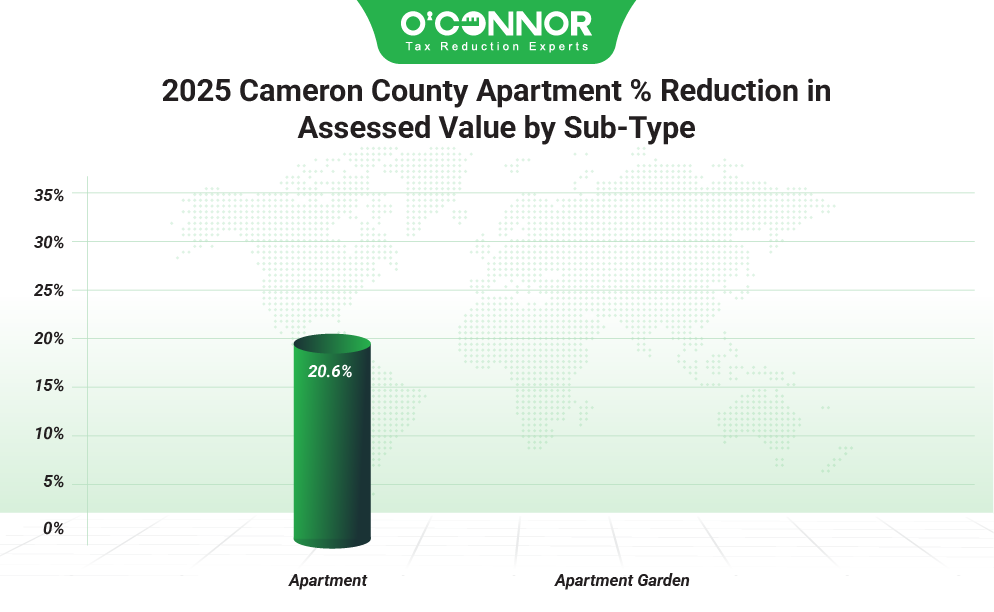
Cameron CAD only used two subtypes for apartments, giving them minimal use as a tool for analysis. Generic apartments achieved a value of $986.33 million following a reduction of 3.6%, while garden apartments saw no real cuts, resulting in a sum of $15.71 million.
Retail Spaces Saved $49.73 in Taxable Value, Eliminated Increases
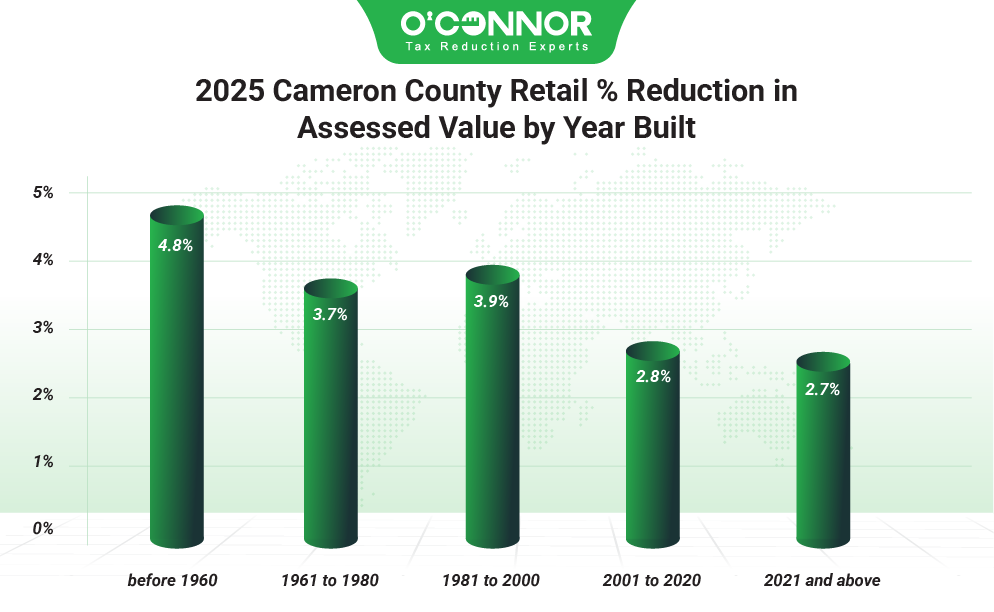
In most large counties, retail properties tend to be one of the lowest categories. Not so in Cameron County, where they were in third place. Despite their high total, retail stores only added 1.4% to their taxable value, which was eliminated easily by an appellant decrease of 3.5%. The established pattern held true, and 40.9% of value came from properties constructed from 2001 to 2020, though these did see a cut of 2.8%. $440.62 million, or 31.8% came from those built from 1981 to 2000, landing a cut of 3.9%. Older stores built from 1961 to 1980 reached a total of $208.36 million after a decrease of 3.7%. The only timeframe not to be reduced beyond their corresponding increase was new construction, which saw an increase of 18.6% before being decreased by 2.7%. We at O’Connor were able to improve on all these figures and ended up giving our clients a total reduction of 8.7%.
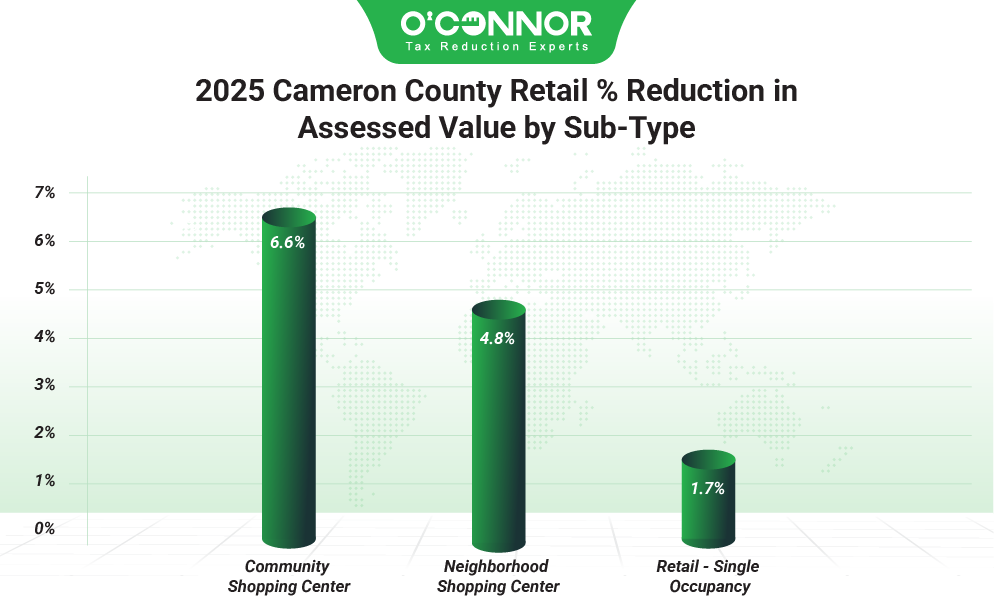
There were three retail categories according to Cameron CAD, which was a bit smaller than typical for Texas. Single-occupancy buildings, also known as big box stores, were the No. 1 subtype with $727.07 million, thanks to a reduction of 1.7%. Neighborhood shopping centers followed with $477.40 million, while community shopping centers logged $183.01 million. These saved 4.8% and 6.6% respectively.
Cameron County Needs More Protests
When they were used, property tax appeals had a great effect on the bottom line. Outside of the land outlier, commercial properties did well in counterpunching the increases handed out by Cameron CAD. This demonstrates the efficacy of protests, even in a limited number. Be it homes or businesses, Cameron County is in dire need of more appeals. With a tiny fraction of the population standing up for their rights, some good reductions overall were seen. This could easily be extrapolated to larger savings if there was more participation. Many counties see over 30% of all properties protest each year, setting a good benchmark for taxpayers in Cameron County to target. Even though protests were relatively few, they still brought back a solid $270.65 million in taxable value, showing just how potent motivated taxpayers can be.
Proudly, we at O’Connor were able to secure great results for our clients across Cameron County. The county has been one of our main points of focus, and we have been getting solid results. We were easily able to beat the overall reduction numbers across the county and managed to reduce our clients’ taxable value by $32.66 million. There is no fee or charge to join O’Connor, and we will protest your taxes to the appropriate level every year. You will only be charged a contingency fee from your savings if you win, even in a lawsuit or judicial appeal.

